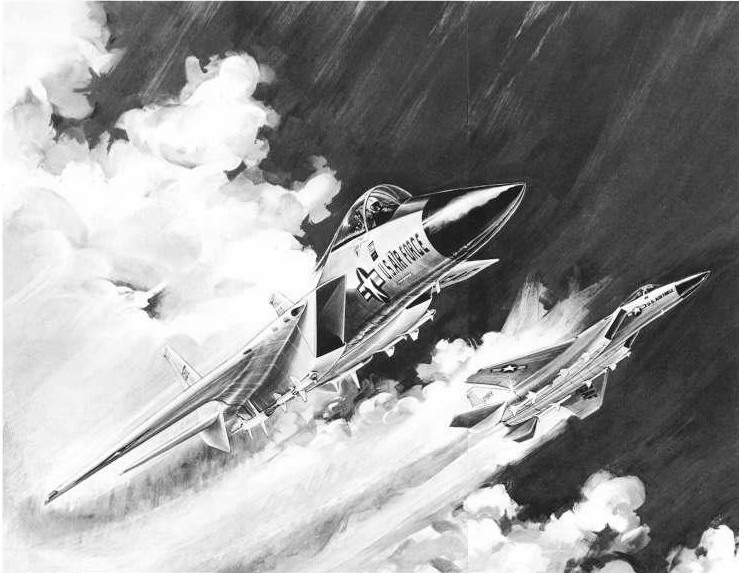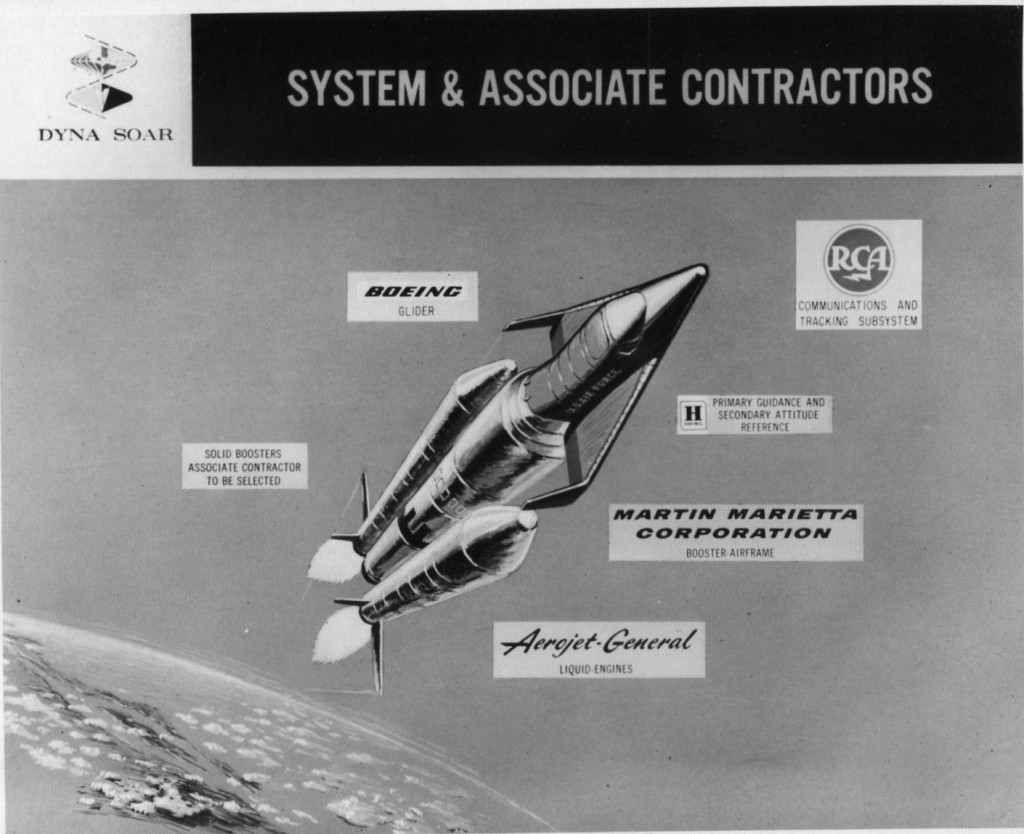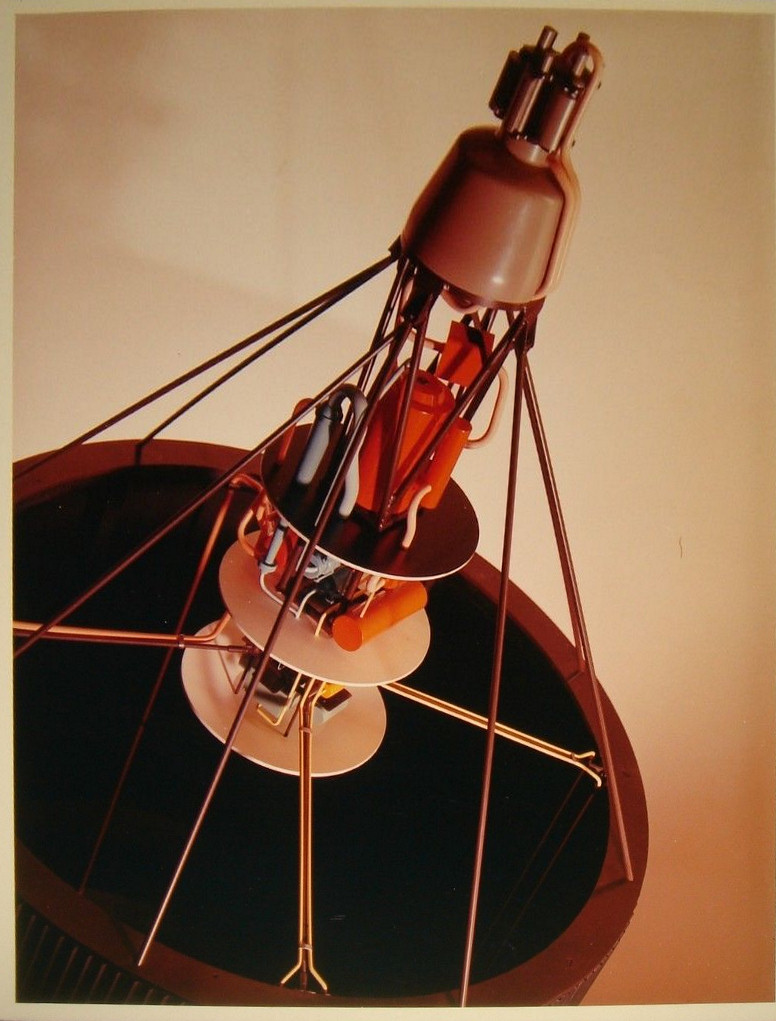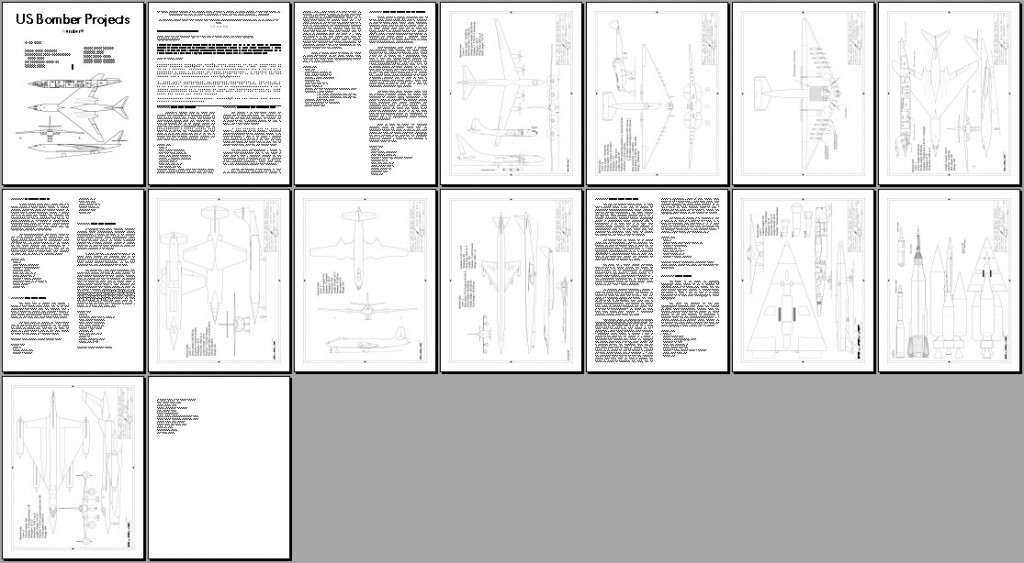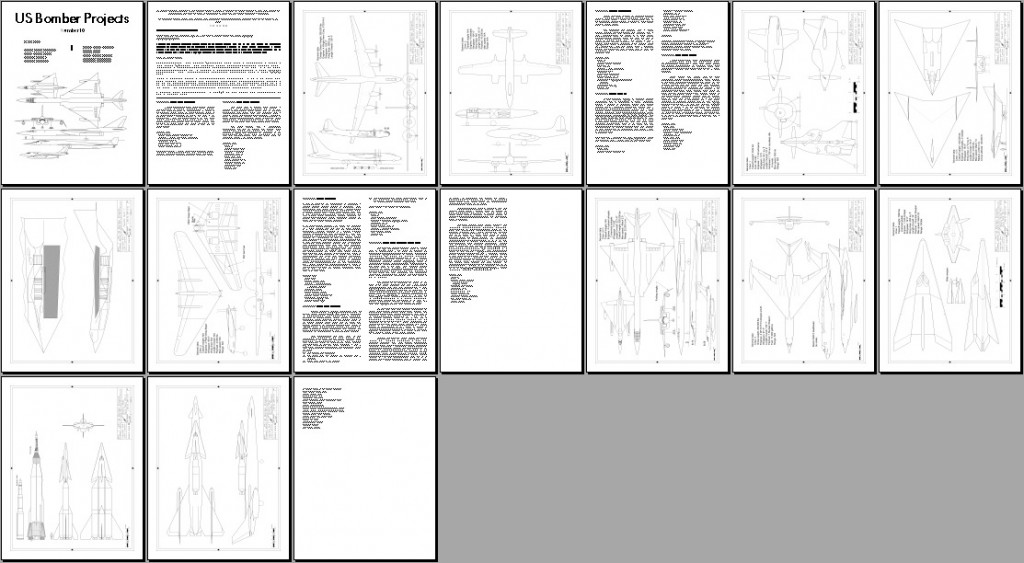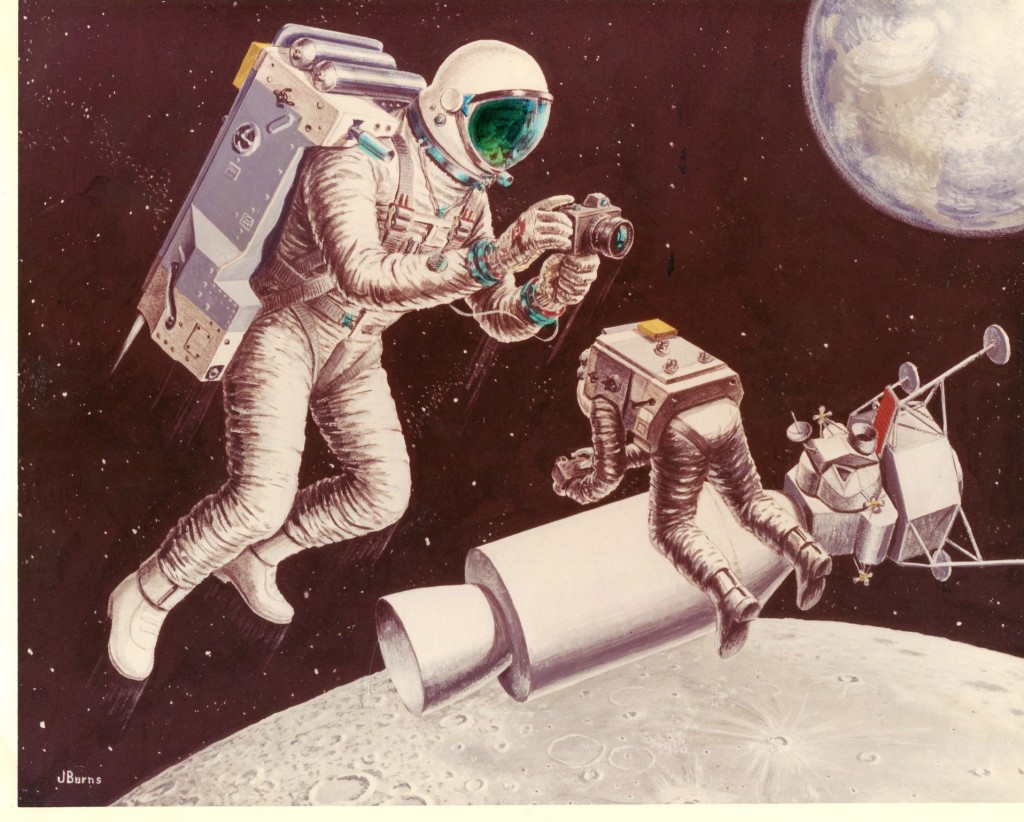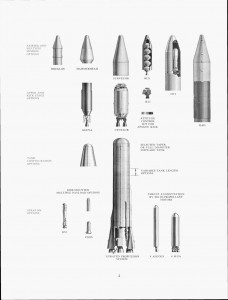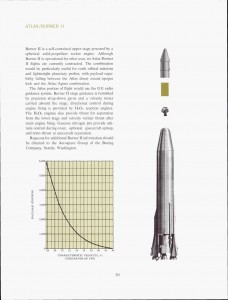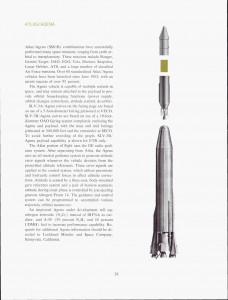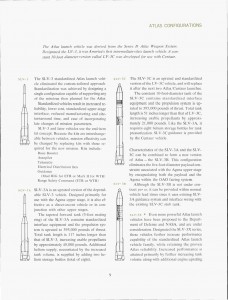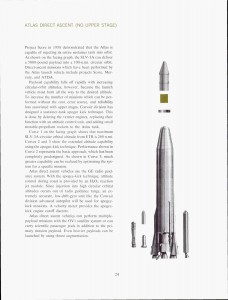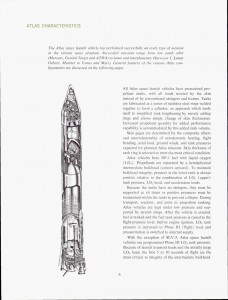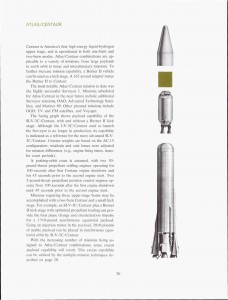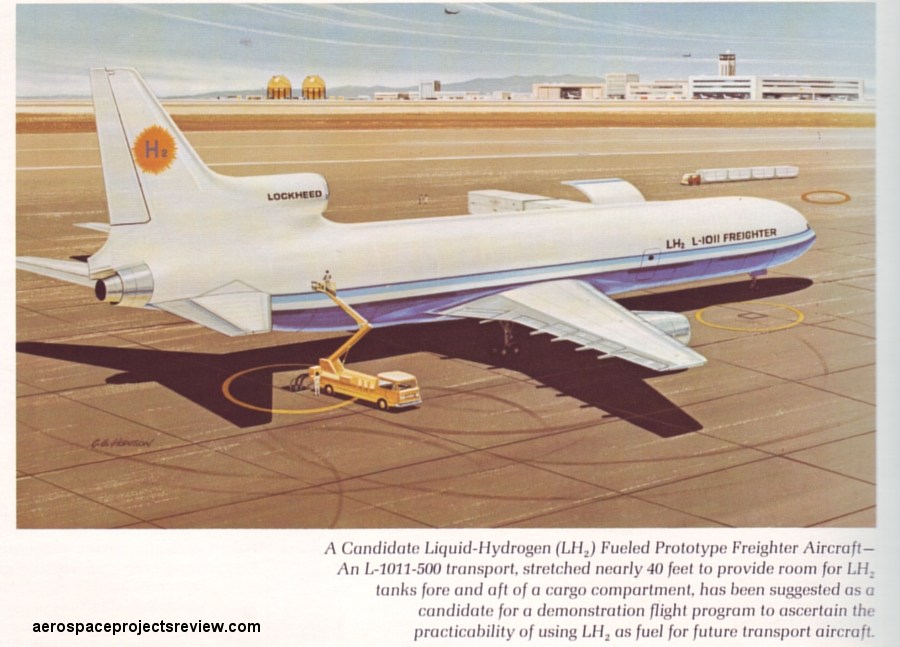McDonnell Douglas artwork from ~1970 showing the F-15 late in the design process. While it’s recognizably the F-15, a number of differences are visible, primary being the ventral fins and slimmer nose.
Artwork showing the major Dyna Soar/Titan III contractors. The Titan IIIc show here includes the large pitch stabilization fins (and small yaw fins) attached to the solid rocket boosters. Not depicted are the thrust vector control fluid tanks. At the time, the fins were thought needed to counteract the pitch moment that would be produced by the wings of the spaceplane way up front. In the end, it was concluded that thrust vector control would be more than adequate for the task; and while the Titan IIIC never launched a Dyan Soar, it retained the TVC capabilities that were produced to deal with the Dyna Soar.
Much, much more on the Dyna Soar, including the final few Titan III variants, can be found in Aerospace Projects Review issue V3N4.
Spotted on ebay a while back. The writeups suggested that this was the actual SNAP 8 #2 reactor, but it sure looks like a mockup to me. The SNAP-8 reactor could generate a healthy 1 megawatt of thermal energy using 18 pounds of nuclear fuel.
Well, here’s a new one. I’ve been put in touch with a guy who has an entire aerospace archive he’s selling off. He wants $4000 for the complete set of stuff, a catalog of which is included here as a PDF (the items actually available in the collection are bounded in red). There’s some undeniably interesting stuff in there that I really want, but $4K is well beyond what I can pony up. But I think this stuff might be of interest to a whole lot of other folks. So what I’m thinking… crowdsource this purchase.
There are two groups of documents that I think would be of most interest, so I will provide high-rez scans of the docs for $150 for group A, $100 for group B, or $225 for both).
Group A: shown on page 3, “Space Shuttle Systems Handbook” and “Hubble Space Telescope Systems Description Handbook.” These are fairly enormous collections of diagrams; the original sales price of these two items back in 1993 was $558. I’ve seen a much more recent version of the Shuttle Handbook,” and it was fairly spectacular.
Group B: shown on page 6, a number of “Shuttle Systems Data Reports” which would seem to illustrate just about everything on the Shuttle program. These I have *not* seen personally, so I’m kinda guessing here. The total sales price in 1993 was $258.
As for all the other stuff: I think the best approach would be to auction them off – after scanning, of course – to those who have bought in for either Group A or B. Right now I’m not asking for cash. There are some details I need to confirm first (such as getting photos of the collection… not that I don’t trust the guy, but I don’t trust anybody). But I *do* want to gauge interest, to see if I will actually be able to afford the full $4K. So if you’d like to get in on this, please send an email to scottlowther@ix.netcom.com letting me know if you wants Group A, Group B or both. If I go ahead with this, I’ll need the funds up front.
A 1970’s (and boy does it show) film by NASA that *briefly* depicts O’Neill cylinder colonies, but mostly deals with the Stanford Torus:
[youtube EgrdAUFFMrA]
Issues 09 and 10 of US Bomber Projects is now available (see HERE for the entire series). Issue #09 includes:
- Boeing Model 464-33-0: A turboprop B-52 predecessor
- Consolidated Army Bombardment Flying Wing: A ground attacker with an extreme mode of attack
- GE Supersonic System 6X: A Mach 3 nuclear-powered bomber
- Convair B/J-58: A supercuising version of the Hustler
- Boeing model 484-2-2: AB-58 competitor
- Northrop 464L: A blended wing/body spaceplane
- Martin Model 223-9: a 1944 step on the road to the XB-48
- Boeing Model 800-15A: A Mach 3.5 hydrogen fueled design of incredible range
USBP#09 can be downloaded as a PDF file for only $4.25:
——–
————————
Issue #10 includes:
- Boeing Model 464-34-3: A turboprop B-52 predecessor
- Martin Model 192-5: A medium-sized flying wing
- Republic Mach 7: a relatively small high-speed design
- Convair WS-125A: A large nuclear powered supersonic design
- Boeing model 484-415: A jet-powered supersonic flying boat
- Boeing 464L: Boeings first Dyna Soar
- Martin Model 223-10: a 1944 step on the road to the XB-48
- Lockheed CL-1301-1: A very small VTOL ground attacker
USBP#10 can be downloaded as a PDF file for only $4.25:
——–
——————-
A piece of NASA art (a photo from eBay, with an attempt at correcting parallax error), likely from 1962-63, depicting current and forthcoming space launch vehicles. Of note, rather obviously, is the “Nova” launcher at far right. But also noteworthy are the “Thor Agena B” and the “Atlas Agena B,” both of which are depicted with the Agena upper stage & payloads blacked out. This could be due to security concerns over the Agena configuration… or perhaps the Agena was not yet well defined, and by blacking them out, the artist would not have to depict them (and yet they could be given an air of mystery). It would not surprise me if there is another version of this artwork with the Agenas shown clearly.
An RCA concept from some time in the 1960’s for an astronaut maneuvering unit that was to use voice controls. This would negate the need for hand controls, but it seems unlikely that 1960’s technology was quite up to the task. Image from HERE. Note that while the backpack is depicted in some detail, the Apollo spacecraft in the background is quite inaccurate and minimally detailed.
NOTE: this is the third official “PDF Review.” The idea is to present interesting online resources for those interested in the sort of aerospace oddities that you can find in the pages of Aerospace Projects Review. This little project is supported through my Patreon campaign; at current levels, I’ll post two such reviews per month. If you’d like to see more, or just want to contribute to help me along, please consider becoming a patron. This PDF was originally on the NASA Technical Report Server. But it seems to no longer be there… probably a victim of the needless security panic, NTRS shutdown and subsequent database lobotomy. So, I’m hosting the 17 megabyte PDF file HERE: Advanced Atlas Launch Vehicle Digest
In the mid-1960’s, Convair produced an unknown number of issues of a a magazine-like publication about the Atlas, this being issue #2 from April, 1967. This described the state of the Atlas space launch vehicle at the time… recent successes and configurations available or soon to be available.
Described and illustrated are the various strap-on solid rocket boosters, upper stages and payload fairings available. This is done with quite a number of reasonably high quality engineering diagrams and paintings, trajectory diagrams, data tables and graphs showing payload and velocity ranges. This “digest” would be useful for preliminary payload planning, for missions from 100 n.mi. circular orbits, to geosynchronous transfers, lunar impact missions and planetary flyby missions as far as Pluto.
The illustrations are, as might be expected from a 1967-vintage publication, all non-computer generated.
—————
As the OPEC oil embargo of the 1970’s ground down the American economy and jacked up the cost of transportation, many studies were made of alternative propulsion systems. For cars and buses and the like, electrical systems were at least theoretically feasible, though even today fully electric ground transport remains problematic. But electric aircraft were out of the question. Similarly, jetliners could not be retrofitted to burn coal or wood, or run off solar power. So that limited the options. One available option was liquid hydrogen. Long since proven on rockets, liquid hydrogen had been used to power jet engines in an experimental capacity. In theory it makes great jet fuel… lots of energy, and produced with no need of oil whatsoever (a nuclear reactor and an electrolysis system can do it, though there are more efficient means). But there were two major down sides: it’s a serious cryogen, requiring vacuum dewars for storage, and the density is pathetically low. Thus a jetliner would need fairly gigantic fuel tanks.
Lockheed of course studied the idea, using their last commercial airliner, the L-1011, as the basis. One concept called for giant fuel tanks to be carried on the wings, making the plane look almost like three aircraft flying in close formation; another idea was to stretch the fuselage and insert propellant tanks in front of and behind the passenger compartment. This would of course separate the passengers from the pilots. Also studied was the same idea but for an L-1011 freighter, artwork for which is shown below.
The idea would have almost certainly worked. But it would have been a logistical headache of the worst kind. None of the existing airport refueling infrastructure would have been usable, and the crews would have to be especially trained. Jet fuel can be stored in simple tanks; liquid hydrogen needs much more careful management to minimize boiloff.
